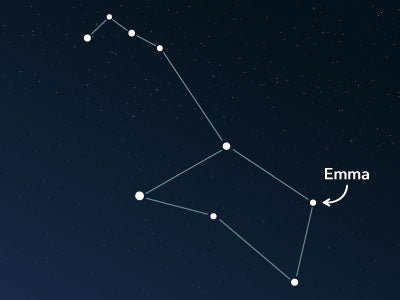The constellation Puppis
Características
- Nombre latino
- Puppis
- Hemisferio
- Hemisferio sur
- Visibilidad
- January - May
- Área
- 673 deg²
- Estrella más brillante
- Naos (HIP number 39429)
- Especialidades
- Open star clusters, globular clusters, planetary nebula

The constellation Puppis is also known under The Poop Deck or The Stern. It is one of the 48 constellations described in ancient times by the Greco-Roman astronomer Claudius Ptolemy. It lies in the southern night sky and contains four bright stars as well as several exciting deep-sky objects.
Hemisphere, visibility, and area
Puppis lies south of the celestial equator and, due to this, can only be perceived from southern regions. It is visible from about the 38th north latitude. That means it can be observed from all places more southern than, for example, Lisbon in Portugal, Seoul in South Korea, or San Francisco in the US. The best period for this is January to May.
The constellation stretches over 673 square degrees and lies east of the Canis Major. Also, the constellations Monoceros, Pictor, Columba, Carina, Vela, as well as Pyxis and Hydra, belong to the neighborhood.
The brightest star Naos (Latin: ζ Puppis, Zeta Puppis), is a blue supergiant with an apparent magnitude of about 2.21. Its distance to earth is about 1,100 light-years. Compared with the sun, its diameter is 40 times larger, it comprises 60 times the mass, and it has a luminosity 790,000 times greater.
Specialties in the constellation
Through the western area of the constellation runs the Milky Way. Therefore, there are several open star clusters, a globular cluster, and a planetary nebula in Puppis.
One of the star clusters is NGC 2437 or M46 (Messier 46). It is about 5,400 light-years away and contains stars that are about 300 million years old. In a telescope, it can be resolved into many individual stars.
To the north of M46 lies the planetary nebula NGC 2438. Visually, the two objects appear to belong together, but the nebula is about 2,500 light-years farther away.
Both objects are located in the north of the constellation, near the adjacent Monoceros.

The globular cluster has the catalog number NGC 2298. James Dunlop discovered it in May 1826. It is not very bright and conspicuous.
Mythology and history
The origin of the constellation Puppis lies in Greek mythology and the constellation Argo Navis, which is no longer recognized today.
Argo Navis represented the ship on which the hero Jason, a son of King Aison of Thessaelia, traveled to Colchis. There, together with his companions, the Argonauts, he tried to get the Golden Fleece. The Golden Fleece was the skin of the ram Chrysomeles, who could not only speak but also fly.
Jason had to undertake this dangerous journey because his power-hungry half-brother Pelias had deprived him of his succession to the throne. Only by handing over the Golden Fleece to Pelias would he be able to return to the throne. By this seemingly impossible task, Pelias hoped to get rid of his half-brother Jason. Because the Golden Fleece was guarded by a menacing dragon, whose fight not infrequently ended fatally.
In the end, however, Jason gained possession of the fleece with the help of the king's daughter Medea. In honor of all involved, the ship Argo Navis and the Golden Fleece were placed in the sky as constellations. The latter was introduced as the constellation Aries.
In 1763, the French astronomer Nicolas Louis de Lacaille divided the two constellations during his redefinition. Because he wanted the large constellation of Argo Navis to be more precise. So, he finally divided it into the Puppis (The Poop Deck), Vela (The Sails), and Carina (The Keel).
PublicadoLeer más artículos interesantes

An overview of all 88 constellations
Learn more about all 88 constellations and read interesting information about the mythology, visibility, and features.

Planetario App
¡Descubre el cielo nocturno con nuestra aplicación de planetario!
Disponible para iOS y Android.

Nombrar una estrella en la constelación The Poop Deck, The Stern
Name a star in a constellation and create something that lasts for eternity.